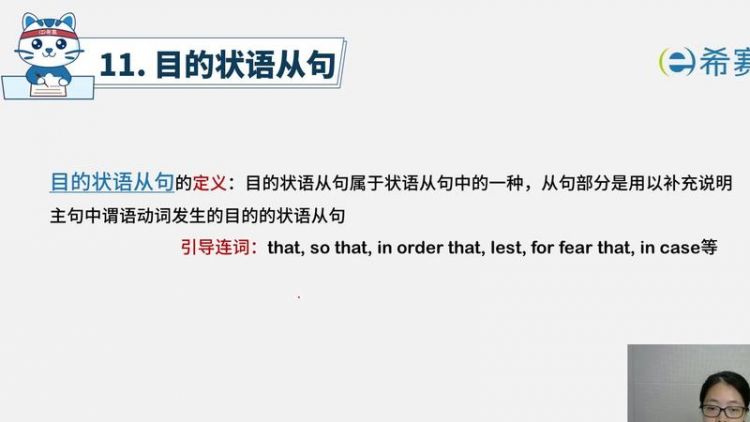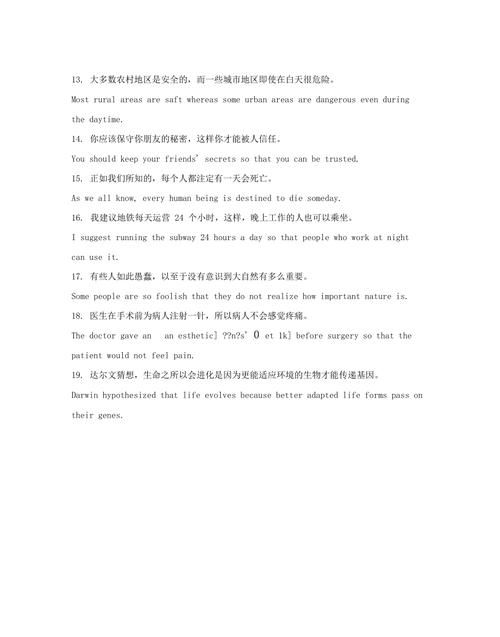本文目录
时间状语从句如何翻译
状语从句如何翻译?
引导语:状语从句内容丰富,涉及面广,可以用来表示时间、原因、条件、让步、目的、结果、等意义,那么状语从句如何翻译呢?下面就和我一起来看看方法吧。
一、时间状语从句
在英语中,时间状语从句的连接词常常有:when(当...的时候),whenever(每当...),as(当...时), since(自从...),until(直到...,如果不....),till(直到...),before(在...前),after(在...后),as soon as(一...就),once(一旦...),the moment(一...就),immediately(一...就),the day(在...那天),no sooner... than(一...就),hardly(scarcely)... when(一...就),the instant(一...就),instantly(一...就),directly(一...就),the minute(一...就),the second(一...就),every time(每当...),by the time(等到....的时候)等。翻译的时候,一般翻译在主句的前面。
(一)译成相应的时间状语
While she spoke, the tears were running down.
她说话时,泪水直流。
As he finished the speech, the audience burst into applause.
他结束讲话的时候,听众掌声雷动。
(二)译成“一(刚、每)...就”的结构
Directly he uttered these words there was a dead silence.
他刚说出这些话,大家就沉默下来。
(三)译成条件句
由于时间状语的引导词除了显示时间关系之外,有时候可以表示条件关系,
所以还可以翻译为条件句。
Turn off the switch when anything goes wrong with the machine.
如果机器发生故障,就把电门关上。
A body at rest will not move till a force is exerted on it.
若无外力的作用,静止的物体不会移动。
二、原因状语从句
英语中,原因状语从句的连接词常常是:because(因为),since(既然,由于),as(因为),now that(既然),seeing that(既然),considering that(考虑到,因为),in that(在某方面),in view of the fact that(鉴于)。在翻译的时候,大多数原因状语从句可以放在主句之前翻译。
(一)译成表示“原因”的分句,放在主句之前翻译,显示“前因后果”的关系。
The crops failed because the season was dry.
因为气候干旱,作物歉收。
(二)原因状语从句在汉语中的位置,常常是“前因后果”。然而,英语则比较灵活,状语从句可以在主句前,也可以在主句后面。所以在翻译为汉语译文时,也有放在后面的。如果把原因状语从句放在主句后面翻译的话,有时候可以用汉语的“之所以...是因为”的结构来连接。
A gas differs from solid in that it has no definite shape.
气体不同于固体是因为(就在于)它没有固定的形状。
He will get promoted, for he has done good work.
他将得到提升,因为他工作干得好。
Theory is valuable because it can provide a direction for practice.
理论之所以有价值,是因为它能给实践指出方向。
(三)not...because的结构
在翻译由because引导的具有否定意义的原因状语从句时,尤其要注意否定意义的表达一定要确切。not与because发生关系,常常要翻译成“并不是因为...”。
The machine did not move because the fuel was used up.
机器停了下来,并不是因为燃料耗尽了。
三、条件状语从句
英语中连接条件状语从句的连接词常常有:if(如果),unless(除非,如果不),providing that(假如),so long as(只要),on condition that(条件是),suppose that(假如),in case(如果),only if(只要),if only(但愿,要是...就好了)等。条件状语从句在翻译的时候,可以翻译在主句之前,也可以翻译在主句后面,有时候,还可以根据上下文省略连接词。
(一)翻译在主句前面。
It was better in case they were captured.
要是把他们捉到了,那就更好了。
If you tell me about it, then I shall be able to decide.
假如你把一切都告诉我,那么我就能够作出决定。
(二)翻译在主句后面,用来补充说明条件。
“如果”、“要是”、“假如”等都是汉语中用来表示“假设”的常用关联词。汉语中表示“假设”的分句一般前置,但作为补充说明情况的分句则往往后置。
You can drive tonight if you are ready.
你今晚就可以出车,如果你愿意的话。
No doubt I could earned something if I had really meant to.
毫无疑问,我本来是可以赚到一点的,如果我真有那样打算的.话。
四、让步状语从句
英语中,表示让步关系的连接词常常有:though(虽然),although(虽然),even if(即使),as(尽管),while(尽管),whatever(无论什么),wherever(无论哪里),whoever(无论谁),however(无论怎样),no matter(不论,不管),for all that(尽管),granted that(即使),in spite of that fact that(尽管),despite the fact that(不管)等等。翻译的时候,通常把这些让步状语从句翻译在主句前面。
No matter what I say or how I say it, he always thinks I’m wrong.
不管我说什么,也不管我怎么说,他说是认为我错了。
While we can not see the air, we can feel it.
我们虽然看不见空气,但却能感觉到它。
Granted that you don’t like the proposal, you shouldn’t have rejected it without consulting others.
即使你不喜欢这个建议,你也不应该没有同别人商量就把它否决了。
五、目的状语从句
在英语中,连接目的状语从句的连接词常常有:that(为了,以便),so that(为了,以便),lest(以防),in case(以防,以免),for fear that(以防)in order that(为了)等等。
(一)一般翻译在主句前面。
一般来说,这种表示“为了”的目的状语从句通常放在主句前面翻译。
We should start early so that we might get there before noon.
为了正午以前赶到那里,我们很早就动身了。
(二)还可以翻译在主句后面,表示“省(免)得”、“以免”、“以便”、“使得”、“生怕”等概念。
They hid themselves behind some bushed for fear that the enemy should find them.
他们躲在树丛后面,以防被敌人发现。
六、结果状语从句
(一)英语中,连接结果状语从句的连词常常有:so that, so...that, such...that, to such a degree等等,通常可以翻译为“结果,如此...以致于...”,可以直接翻译。
He made a wrong decision, so that half of his lifetime was wasted.
他做了错误的决定,结果浪费了自己半生的时间。
(二)有时候,如果在主句中含有“never, never so, not so, not such”等否定词,“but that和but what”也可以连接结果状语从句,构成双重否定。翻译的时候,可以翻译为“没有...不”。
She is not so old but that she can read.
他并没有老到不能读书。
She came in when I was having supper.
我正在吃饭的时候,她进来了。
He pushed open the door gently and stole out of the room for fear that he should awake her.
为了不惊醒她,他轻轻推开房门,悄悄地溜了出去。
;
目的状语从句简单例句
目的状语从句
从句部分是用以补充说明主句中谓语动词发生的目的的状语从句。表示目的状语的从句可以由that, so that, in order that, lest, for fear that, in case等词引导;目的状语从句的谓语常含有may, might, can, could, should, will, would等情态动词。
例句
Say it louder(so)that everyone can hear you.
大声说,以便大家都能听到你。
I am telling you that lest you should make a mistake.
我告诉你这一点,以免你搞错。
I got up early so that I could catch the first bus.
我起得很早,目的是为了赶上头班公共汽车。
She worked hard so that everything would be ready by 5 o'clock.
她努力工作,以便在五点前是一切都就绪。
She looked down so that she should not see his eyes.
她垂下目光,使她看不到他的眼睛。
We'll sit nearer the front so we can hear better.
我们坐的靠前一点,因此,我们听得清楚一点。
He works hard in order that his family may be happy.
为了让家人幸福,他努力工作。
He shouted at the top of his voice,to the that(=in order that)he might be heard.
他高声呼喊,为的是让人们能听见他的说话。
I am punishing the child lest he should make the same mistake.
我惩罚那个孩子,以免他再犯同样的错误。
She took her umbrella lest it(should)rain.
他带了把雨伞,唯恐天要下雨。
Lest the wall(should)collapse,they evacuated the buliding.
他们撤离了大楼,以防墙壁倒塌。
Speak clearly so that they may understand you.
讲清楚些,以便他们能理解你。
He studied hard in order that he could pass the exam.
他努力学习以便能考试及格。
Shut the window for fear that it may rain.
把窗子关上以防下雨。
引导目的状语从句的从属连词
主要的有 in order that, so that, in case, for fear等:
Speak clearly so that they may understand you.
讲清楚些,以便他们能理解你。
He studied hard in order that he could pass the exam.
他努力学习以便能考试及格
Shut the window for fear that it may rain.
把窗子关上以防下雨。
【注】so that 引导目的状语从句时有时可省略so而只用that,有时也可只用so:
Bring it closer that I might see it better.
拿近些,使我能看得清楚些。
I’ll show you so you can see how it’s done.
我将做给你看,以便你知道应怎样干。
目的状语从句与状语短语的转换
为了简洁起见,当目的状语从句的主语与主句的主语相同时,目的状语从句有时可用表目的的不定式短语替换:
He got up early so that he could catch the early bus. / He got up early so as to catch the early bus.
他起床很早以便赶上早班车。
He came in quietly in order that he shouldn’t wake his wife. / He came in quietly in order not to wake his wife.
他轻轻进来,以免把他妻子吵醒。
有时还可与表示目的的介词短语替换:
He left an hour early for fear he might miss the train. / He left an hour early for fear of missing the train.
他提前一小时离开,以免错过火车。
一点注意
in case既可引导目的状语从句,也可引导条件状语从句,主要视句意而定:
In case he comes, let me know.
如果他来,告诉我一声。
Tell me in case you get into difficulty.
遇到困难请告诉我。
【注】in case引导目的状语从句,从句有时可用“should+动词原形”这样的形式:
Take your coat in case it rains (should rain).
带着雨衣以防下雨。
参考资料
英语语法网:***/Article/200802/126.html

英语中的结果状语从句是什么
1. 楼主迷茫的原因更多在于语文,而不是英语啊。
2. 第一个例句:He was so weak that he couldn't walk on.
解释:so...that...意思的确是“如此...以致...”,that引导的也的确是结果状语从句,而不是楼主所理解的目的状语从句。
“以致于...”中的“致”的含义同“导致”,那其后不是结果还会是目的吗?
3. 至于so that...其后引导的从句既可能是结果状语从句,也可能是目的状语从句。到底是哪一种,要根据句意具体加以判断。
1)如果是结果状语从句的话,则翻译为“以致于...”;
2)如果是目的状语从句的话,则翻译为“以便于...”。
4. 第二个例句:We will sit near the front so that he couldn't be seen.
“ ???坐的离前台很近,所以我们???能听的很清”?
此句有时态错误,即will和couldn't无法对应;
且中文翻译和英文原句无法对应,无法进行相应分析,抱歉!
5. 第三个例句:He sat in the dark so that he couldn't be seen.
他坐在黑暗处所以人们看不见他。/ 他坐在黑暗处,以便于人们看不见他。
此句的确如楼主所言,存在歧义,即可表示目的,也可表示结果。
6. 最后想要提醒楼主的是,so that引导目的/结果状语从句的区别主要如下:
1)表目的时,翻译为“以便于...”,且从句一般含有can/could等情态动词;
2)表结果时,翻译为“以致于...”,so that前面多数情况下会有逗号隔开。
7. 希望以上能对楼主有帮助。不到之处也望楼主提出,以互相切磋,共同提高。

时间状语从句的例题及答案解析
Adverbial Clauses
状语从句 1.分类
英语状语从句可表示时间、地点、条件、方式、让步、原因、比较、目的、结果等意义。不同的状语从句要求不同的连词或相当于连词的词组引出。以下是常用的引导状语从句的连词:
时间状语:when, while, as, before, after, since, until, the moment, as soon as
地点状语:where, wherever
条件状语:if, unless, as/so long as, suppose
方式状语:as, as if, as though
让步状语:though, although, even if, even though
原因状语:as, because, since, now that
比较状语:as...as, than, the...the, not so...as
目的状语:so that, in order that, for fear that, in case
结果状语:so that, so...that, such...that, that 2.时间状语从句
The street were less crowded when Mr.Budd let him out.
巴德先生让他出来的时候,街上行人已少了一些。
I'll come back as soon as is over.
一下课我就回来。
Please don't go anywhere before I come back.
我回来之前,哪儿也别去。
The telephone rang while I was having a bath.
我洗澡时,电话铃响了。 1)表示将来时间时,时间状语从句须用一般时态代替将来时态。
We will go fishing if it is fine tomorrow.
如果明天晴,我们就去钓鱼。
Soon after you jump, the parachute will open.
你一跳,降落伞就会打开。 2)when, while, as在引导时间状语从句时的区别:when表示从句的动作与主句的动作一个紧接着一个发生,也可表示从句动作在主句动作之前或之后发生。从时间上来说,它既可指一段时间,也可指某一具体时刻。
She opened the door when she heard the door bell.
她听到门铃响就把门打开了。
When he called, I was making lunch in the kitchen.
他来电话时,我正在厨房做午餐。
I used to eat in small restaurants when I was in London.
我在伦敦时,常在小饭馆吃饭。
I'll tell him about in when I see him.
我看到他时我会告诉他的。 while表示从句的动作与主句的动作同时发生,从句动作往往是有延续性的,因此从句所用的谓语动词往往是延续性的动词。从时间上来说,while指一段时间。
The light went out while I was reading the newspaper.
我正在读报时,灯灭了。
He repaired the leaking tab while the rest of the family were watching TV.
家里其他人在看电视的时候,他把漏水的龙头给修好了。
as表示某事发生的过程中另一件事发生了,亦可用来表示两个同时发生的动作。
As I drove past the crossroads, a red car suddenly shot right past me.
我开车过十字路口时,一辆红色的轿车突然从我旁边飞驰而过。
A look of surprise came into his eyes as he read the message.
他读着条子,眼里流露出吃惊的神情。
As he did so he nearly ran into a large man who suddenly came in through the doorway.
就在他这么做的时候,他几乎与一个突然进来大个子撞了个满怀。 3.地点状语从句
where, wherever引导地点状语,意思与in/at/to/the place where接近。
I'll drive you wherever you are going.
你去任何地方我都开车送你去。
You have the right to live where you want.
你有权住在你想住的地方。
It's your fault that she is where she is.
她落到今天这个地步是你的错。
Where there is a will, there is a way.
有志者事竟成。 4.原因状语从句
引导原因状语从句的连词主要有because, as, since。because表示的语气最强,通常用于回答以疑问词why引导的疑问句。as和since表示的原因通常对方是知道的,since较as正式。because可以代替as, since,但as和since不一定能代替because。
He failed the exam because he didn't study hard.
他考试不及格是因为他学习不努力。
He distrusted me because I was new.
因为我是新来的所以他不信任我。
As it is raining, you'd better take a taxi.
正在下雨,你最好乘出租车。
As all seats were full, he stood up and gave up his to an old lady.
由于所有的座位都有人了,他就站起来把他的座位让给了一位老太太。
Since you are going, I'll go, too.
既然你要去,那我也去。
Since you have no objection, let's get started.
既然你不反对,那就让我们干吧。 5.目的状语从句
She ate her supper quickly so she could go out early.
她很快吃晚饭以便能早点出来。
They drove with both windows closed so that he would not catch cold.
他们开车时把两边的窗子都关上了,这样他就不会感冒。
Speak clearly so that they will understand you.
说话清楚点好让他们明白你的意思。
These men risk their lives in order that we may live more safely.
这些人冒着生命危险是为了让我们更加安全地生活。
Don't let your baby play with your watch in case he damages it.
别让你的孩子玩你的表以免把表弄坏。
I'll buy some beer in case Uncle Tom drops in at the weekend.
我要去买些啤酒以备周末汤姆叔叔来。
目的状语从句中常用can/could, may/might, will/would, shall/should等情态动词。
He wore a pair of sunglasses for fear that he would/might be recognized.
为了不让人认出来,他戴了一副墨镜。 6.让步状语从句
Though we have worked with John for years, we don't know much about his family.
尽管我们和约翰一起工作多年,我们对他的家庭还是了解甚少。
Even though you don't like him, you should be polite.
尽管你不喜欢他,你还是应该礼貌一些。
Although we were poor, we were very happy.
尽管我们穷,但我们很快乐。
He is a good man even though I don't always agree with him.
尽管我们的看法有时不同,但他人是好的。
Even if he proves to be wrong, he wouldn't admit it.
即使已经证明他错了,他也不会承认。
as也可引导让步状语从句,但只用在形容词/副词+as+主语+谓语的结构中。这一结构主要用于正式文体,不用于非正式文体。
Patient as he was, he had intention of waiting for three hours.
尽管他很有耐心,但他还是不打算等三个小时。
Young as he is, she has five years of teaching behind her.
尽管她还年轻,但她已经有五年的教学经历了。
Hard as he tried, he couldn't cope with his responsibilities as manager.
尽管他很努力,但他实在不能胜任经理的职责。 7.方式状语从句
Do as you are told.
叫你怎么做你就怎么做。
I've changed the title of the essay as you suggested.
我已经照你所建议的那样把文章的题目改了。
She had never spoken so excitedly as she did then.
她说话从来也没有像那会儿那样激动过。
The other day he spoke about John as if he knew him.
前两天他谈起约翰,就好象他认识他似的。
I remember the whole thing as if it had happened yesterday.
整件事我都记得,仿佛它就发生在昨天。
He told us what had happened yesterday as if he had witnessed the whole thing.
他把昨天发生的事情都告诉了我们,就像是他亲眼目睹了一切似的。 8.结果状语从句
One of her lungs is affected a little so she has to rest.
他的一叶肺有点感染,所以她得休息。
I missed the bus so I didn't get home until very late in the evening.
我没赶上汽车,所以晚上很晚才到家。
His father works so late every day that he hardly ever sees him.
他父亲每天都工作到很晚,他几乎见不到他。
His heart beat so fast that he could hardly breathe.
他的心脏跳得那么快,他几乎不能呼吸了。
It gave him such a shock that his face turned white.
这使他大吃一惊,以至他的脸都白了。
What's the matter with you that you look so worried?
你看上去忧心忡忡的,出什么事了?

以上就是关于目的状语从句英文翻译,时间状语从句如何翻译的全部内容,以及目的状语从句英文翻译 的相关内容,希望能够帮到您。

